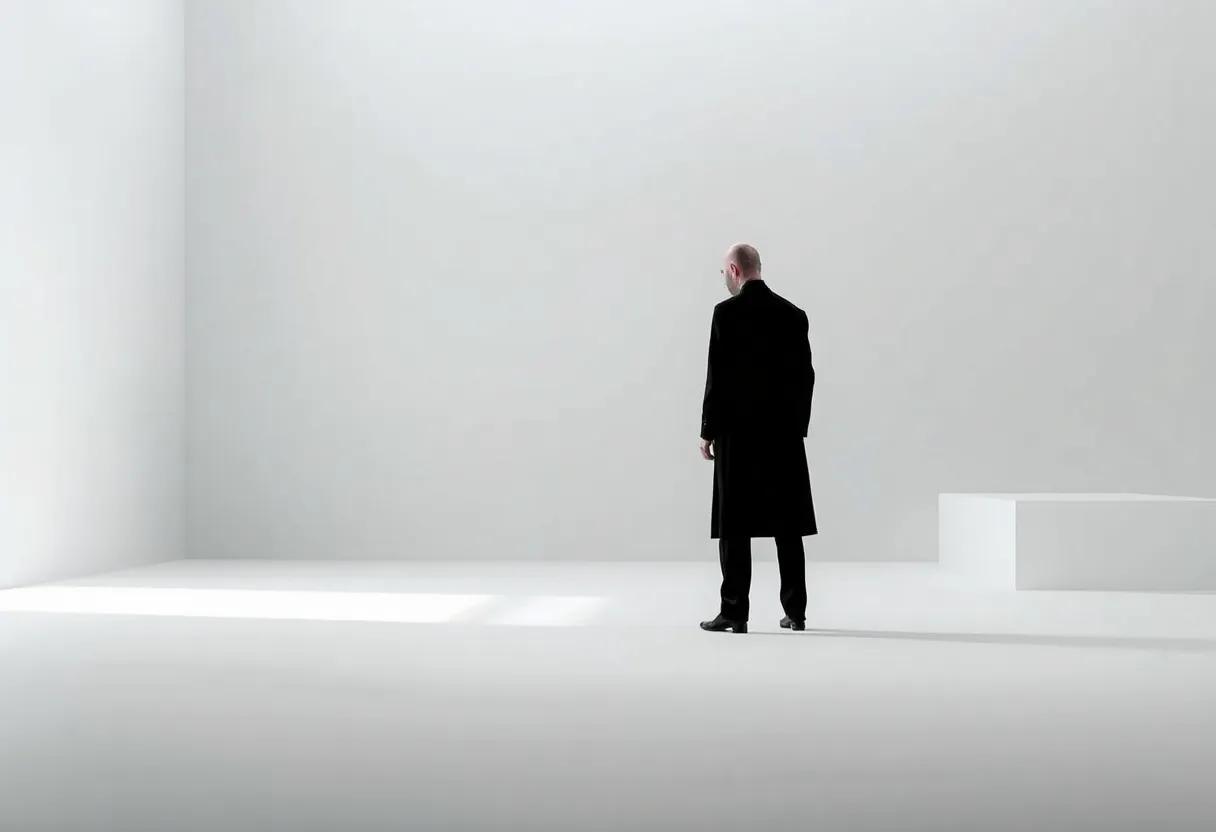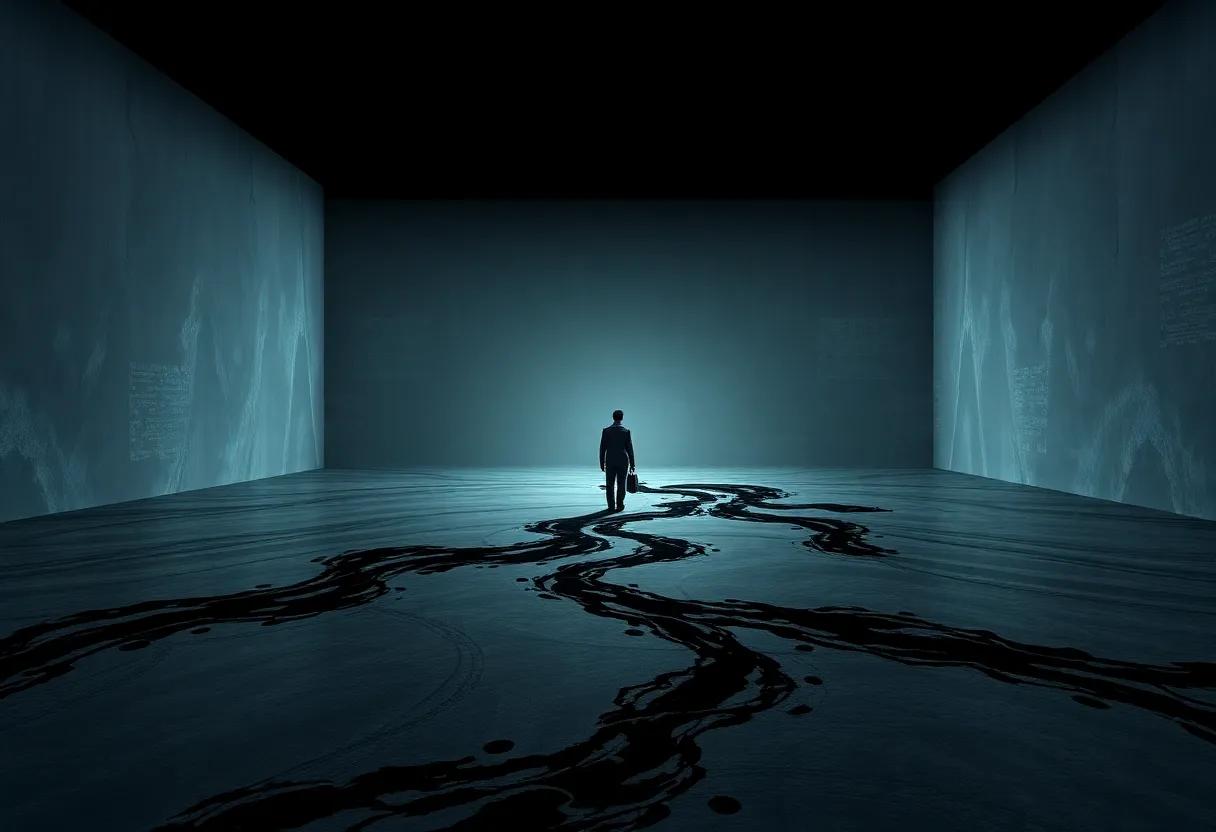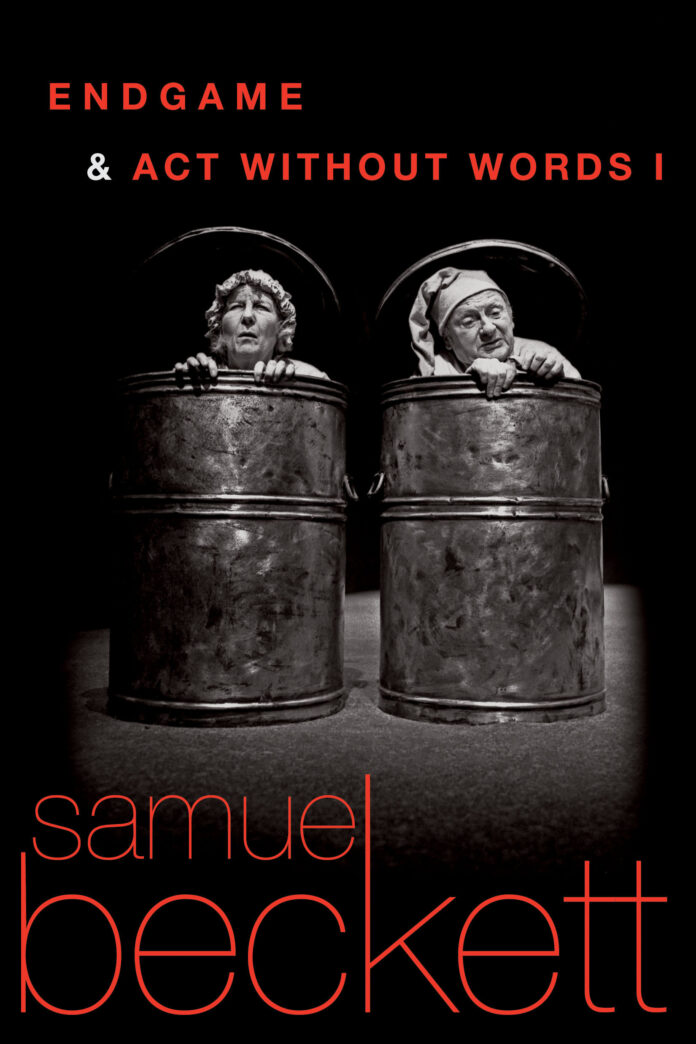In the shadowed corners of Samuel Beckett’s theatrical universe,silence speaks volumes and finality lingers like an unrelenting echo. ventures into these profound spaces, offering a thoughtful exploration of two of Beckett’s most emblematic works. This review delves into the intricate interplay of language, gesture, and existential stillness that define Endgame and Act Without Words, inviting readers to reconsider the fragile boundaries between action and inaction, speech and silence, presence and oblivion. Through a careful and measured lens, the book navigates the minimalist landscapes Beckett so masterfully crafts, shedding new light on the enduring questions at the heart of his theater.
Exploring the Thematic Depths of Beckett’s Endgame and Act Without Words Through Silence and Minimalism

Beckett’s mastery lies not just in what is spoken but profoundly in what remains unspoken. Silence becomes a language-a canvas where existential despair, human dependence, and the collapse of meaning unfold without the distraction of verbose dialog. In both Endgame and Act Without Words, the sparseness of words forces audiences into an uncomfortable intimacy with the void. The deliberate minimalism reveals characters trapped in cyclical routines, their gestures and silences echoing the futility of searching for purpose in a world stripped to its bare essentials. This stripped-back framework compels the viewer to confront silence not as absence but as a resonant presence, a profound pause laden with the weight of finality and unresolved tension.
The dramaturgy uses minimal props and restricted movement to intensify the theme of entrapment and stasis, reflected starkly in the plays’ visual tableaux. Consider the following elements that Beckett invokes to communicate through stillness:
- Static staging: Fixed positions create a claustrophobic atmosphere, emphasizing emotional paralysis.
- Sparse dialogue: Each word is deliberate,generating layers of meaning beneath seemingly simple exchanges.
- Repetitive actions: Ritualistic behavior underscores the cyclical nature of suffering and inertia.
- Emptiness of space: Negative space enhances feelings of isolation and the existential void.
| element | Thematic Impact | example |
|---|---|---|
| Silence | Conveys absence and tension | Long pauses between characters |
| Minimal Props | Focuses attention on human condition | Endgame’s ashbins and chairs |
| Repetition | Highlights futility and time’s cyclicity | Routine dressings and undressings |
How Beckett Uses Stark Settings to Amplify the Human Condition in Endgame and Act Without Words

Beckett’s choice of bleak, stripped-down environments serves as a powerful canvas upon which the rawness of human existence is laid bare. In both Endgame and Act Without words, the absence of elaborate scenery strips away distractions, allowing the audience to focus on the existential solitude and helplessness that define the human condition. These stark settings are not just backdrops but active participants, emphasizing themes of entrapment, desolation, and the cyclical nature of life. The constant interplay between emptiness and confinement magnifies the characters’ vulnerability, making their silent struggles and repetitive gestures all the more poignant and profound.
The minimalist stages highlight several recurring motifs that Beckett weaves throughout his work, each intensified by the bare surroundings:
- Isolation: Characters are physically and emotionally enclosed, underscoring the loneliness at the heart of human existence.
- Stasis: Lack of movement in the environment reflects the characters’ psychological impasse, mirroring life’s inertia.
- Absurdity: The incongruity between characters’ desires and their inert surroundings amplifies the futility and paradoxes of life.
| Element | Endgame | Act Without Words |
|---|---|---|
| Setting | Bleak room with boarded windows | Empty stage with a single prop |
| Movement | Repetitive, limited | Silent, pantomime-driven |
| Atmosphere | Claustrophobic, oppressive | Desolate, enigmatic |
The Role of Nonverbal Communication in Conveying Emotion and meaning Within Beckett’s Plays
In Beckett’s works, silence often speaks louder than words, and the physicality of his characters becomes a language unto itself. The actors’ movements,gestures,and postures are meticulously crafted to convey layers of emotion far beyond dialogue. For instance, in Act Without Words, the protagonist’s repetitive, often futile actions reflect not just physical constraints but also an internal struggle with meaning and existence. This nonverbal communication creates an atmosphere where every twitch, pause, and stumble resonates with a palpable sense of desperation and finality, leaving the audience to decode a rich emotional vocabulary hidden beneath the surface.
Key elements of Beckett’s nonverbal language include:
- Gestural repetition: Echoes of hopelessness and resignation embedded in cyclical movements.
- Spatial Relationships: The positioning of characters within restrictive spaces amplifies isolation.
- Facial Expressions: Subtle shifts in expression signal internal conflict or resignation.
- Pause and Silence: Strategic silences that heighten tension and invite interpretation.
| nonverbal Element | emotional Effect | Example Context |
|---|---|---|
| Repetitive Gesture | Despair | Endless button pressing in Act Without Words |
| Frozen Posture | Stasis & Acceptance | Characters seated motionless in Endgame |
| Gaze direction | Alienation | Looking past each other, disconnected |
| Silence | Suspense & Reflection | Delayed responses, pregnant pauses |
Analyzing the Intersection of Finality and Existentialism in Endgame’s Dialogueless Moments
In the silent expanse of Endgame‘s most dialogue-free sequences, Beckett orchestrates a profound meditation on the nature of finality. The absence of words does not denote emptiness; instead, it amplifies the weight of existence teetering on the edge of cessation. These silent moments become charged with existential tension, where the characters’ frozen gestures and minimalistic movements echo the human condition’s inertia against certain oblivion. The muted interactions serve as a canvas upon which Beckett paints the unspoken despair and the paradoxical persistence of being, inviting viewers to reflect on life’s cyclical stagnation and the inescapability of conclusion.
To further unravel this intersection, consider how silence functions within the framework of existential themes:
- Silence as existential Void: The absence of speech mimics the abyss of meaninglessness faced by Beckett’s characters.
- Finality as an Unseen Presence: It looms quietly, shaping action and stillness alike without explicit declaration.
- Gestural Language: Movements replace dialogue, highlighting communication’s fragility in the face of despair.
| Moment | Existential Element | implied Meaning |
|---|---|---|
| Stage stillness | Reflection | Contemplation of inevitability |
| Character Pauses | Isolation | alienation in silence |
| Minimal Gesture | Resistance | Struggle against oblivion |
Visual and Auditory elements That Shape the Atmosphere of Beckett’s Work in Act Without Words

Samuel Beckett meticulously engineers the interplay of visual austerity and subtle auditory cues to conjure an atmosphere steeped in existential tension and stark loneliness. In “Act Without Words,” the empty stage becomes a silent canvas where shadow and light choreograph an unspoken narrative. The protagonist’s relentless physical gestures against an inert environment amplify the profound isolation, transforming silence into a language of despair and resilience. Objects like the whip, rope, and ladder are not props but symbolic anchors of human struggle, each movement echoing the futility of action within an indifferent cosmos.
Complementing this visual minimalism is a carefully curated auditory palette that punctuates the void. The occasional rustling fabric, the subtle creak of the stage, or the absence of sound itself becomes an active participant in the play’s profound stillness. Beckett’s use of sound-or its deliberate omission-crafts an environment where anticipation and finality coexist.This sensory strategy intensifies the viewer’s emotional engagement,evoking a haunting atmosphere where every silence speaks volumes. The result is an interplay of senses that transcends words,inviting audiences into a liminal space where meaning is found within emptiness.
- Visual minimalism that emphasizes isolation and existential futility
- Symbolic props that represent human endeavor and restraint
- Strategic use of silence as a powerful auditory element
- Subtle non-verbal sounds enhancing emotional texture
| Element | Function | Emotional Impact |
|---|---|---|
| Whip | Symbolizes control and punishment | Heightens tension and despair |
| Silence | Creates space for contemplation | Elicits introspection and unease |
| Ladder | Represents futile aspiration | Conveys hope mingled with frustration |
Symbolism Behind Beckett’s Characters and their Silent Interactions in Both Plays

In Beckett’s plays,characters often communicate through silence and minimal gestures,transforming the absence of dialogue into a rich tapestry of meaning.the silence in Endgame and Act Without Words is not emptiness but a charged space where characters’ internal struggles play out. Each mute interaction carries layers of symbolism-be it the cyclical nature of dependency, the inescapability of fate, or the erosion of identity. For example, Hamm’s domination over Clov in Endgame reflects both physical confinement and emotional captivity, while the silent attempts of the protagonist in Act Without Words to navigate his surroundings echo humanity’s perpetual struggle against indifferent forces.
Examining the characters’ nonverbal exchanges reveals a complex language of gestures, postures, and pauses that embody the themes of finality and existential limbo. These silent interactions remind us that communication transcends words, frequently enough expressing more profound truth through what’s left unsaid. Below is a quick overview of symbolic motifs tied to Beckett’s characters and their silent acts:
- Stasis and Movement: Immobilization symbolizes death or paralysis of will, while hesitant movements hint at resistance or hope.
- Dependence and Power: The push-and-pull between caretaker and dependent illustrates cycles of dominance and submission.
- Light and Shadow: Physical space and lighting underscore moments of clarity or confusion, illuminating inner turmoil.
| Character | silent Gesture | Symbolic Meaning |
|---|---|---|
| Hamm | blindness & commanding posture | Control entwined with vulnerability |
| Clov | Repetitive movement & silence | Endless servitude and restraint |
| Mute Man (Act Without Words) | Reaching and shielding | Human struggle against fate |
Reader Recommendations for Approaching Beckett’s Challenging and Cryptic Dramatic Style

Diving into Beckett’s minimalism requires patience and a willingness to embrace ambiguity. Rather than seeking conventional plot progression or clear resolutions, readers shoudl focus on the spaces between words and silences.Allow yourself to linger on pauses, gestures, and the stripped-back settings-these elements are Beckett’s language as much as the dialogue itself. To capture the essence, try reading aloud or performing snippets, even when the text appears sparse; the rhythm and timing reveal layers often missed in silent reading.
Practical approaches can enhance comprehension of Beckett’s cryptic style. consider creating a personal glossary of recurring motifs and symbols, noting how thay evolve differently across scenes. Engaging with fellow readers through discussion groups or online forums also opens new perspectives, as Beckett’s work thrives on multiplicity of interpretation. For those who prefer structured guidance, the table below suggests methods and their benefits to approach the plays thoughtfully:
| Approach | Benefit |
|---|---|
| Read aloud in segments | Highlights rhythm and tone |
| Note recurring imagery | Unveils thematic patterns |
| join group discussions | Expands interpretive horizons |
| Revisit after breaks | Provides fresh insight |
Balancing Patience and Insight: Strategies for Engaging with Beckett’s Unique Narrative Techniques
Samuel beckett’s narratives unfold in a realm where time dilates and silence speaks volumes, inviting readers and audiences to embrace a dialectic of restraint and revelation. The key to engaging with his work lies in cultivating patience-allowing scenes to breathe and meaning to percolate beneath the sparse dialogue and minimalistic action. Unlike conventional storytelling that rushes toward resolution, Beckett’s plays operate in a liminal space where pauses, repetition, and fragmented communication accumulate emotional and philosophical weight. Recognizing this rhythmic subtlety is essential; it transforms apparent stagnation into a profound meditation on existence, decay, and finality.
Concurrently, honing your insight sharpens the ability to decode Beckett’s symbolic textures and structural experiments. Notice, as an example, the interplay between physical confinement and psychological isolation in Endgame or the gestures-without-words paradox in Act Without Words. Identifying recurring motifs such as circularity, deconstructed roles, and silent struggle enriches understanding and gratitude. the following strategies enhance this engagement:
- Observe how silence punctuates and intensifies emotional undercurrents.
- Trace symbolic objects or movements carrying hidden significance.
- Reflect on the tension between stasis and implied motion within scenes.
- Appreciate Beckett’s economy of language as a deliberate tool, not merely minimalism.
| technique | Effect | Example |
|---|---|---|
| Repetition | Creates rhythm and highlights existential futility | Characters’ cyclical dialogue in Endgame |
| Physical Constraint | Emphasizes helplessness and confinement | Characters trapped in a room with minimal props |
| Silence | Amplifies tension and invites introspection | Pauses marking transitions in Act Without Words |
| Minimalism | Strips to essentials, focusing on core existential themes | Sparse sets and dialogue, absence of extraneous detail |
Comparing Audience Reception and Critical Interpretations of Silence as a Theatrical Device
Audience reactions to the use of silence in Beckett’s plays often oscillate between discomfort and profound reflection.Many spectators find the strategic pauses and wordless moments unnerving, as they confront a theatrical space stripped of conventional dialogue and action. This absence transforms silence from mere absence into a powerful communicative force, eliciting a range of emotions-from despair to dark humor. For some, the silence is a mirror reflecting the futility of existence, while others interpret it as a compelling invitation to fill the void with personal meaning. The tension generated by these quiet interludes underscores the plays’ existential themes and challenges the audience to engage with the unsaid rather than the spoken.
Critics, on the other hand, approach the silence with a more analytical lens, emphasizing its structural and symbolic roles. They highlight how Beckett harnesses silence not just as a dramatic pause, but as an essential language that defines the rhythm and tone of the narrative. The restraint demands active interpretation, positioning the audience as co-creators of meaning in a sparse theatrical landscape. Below is a brief comparison of audience and critical perspectives:
| Aspect | Audience Reception | Critical Interpretation |
|---|---|---|
| Emotional Impact | Unease, introspection, empathy | Existential symbolism, thematic depth |
| Function | Creates tension, invites personal reflection | Structural pause, narrative device |
| Engagement | Active emotional engagement | Analytical exploration of form |
- audience: Experiences silence as a haunting presence that shapes emotional landscapes.
- Critics: Regard silence as an innovative theatrical language, integral to Beckett’s minimalist aesthetic.
The Impact of Beckett’s Innovative Structure on Modern Drama and Performance Art
Beckett’s radical departure from conventional narrative arcs reshaped the landscape of modern drama and performance art by embracing minimalism and absurdity to magnify the essence of human existence. His fragmented timelines, pared-down dialogue, and spatial constraints invite audiences into a contemplative space where silence speaks louder than words, and finality becomes an ever-present undercurrent. This aesthetic choice challenges performers and directors alike to explore the potency of pauses, gestures, and the very absence of action, transforming the stage into a liminal zone where meaning is not delivered but fractured, leaving interpretation fluid and deeply personal.
Moreover, his innovative use of structure has inspired a variety of experimental forms that blur customary boundaries. Modern performances often incorporate Beckettian techniques such as:
- Delayed resolution: Instead of clear conclusions, unresolved tensions provoke ongoing reflection.
- Spatial minimalism: Sparse sets emphasizing emptiness and isolation.
- Non-linear temporality: Time loops and cyclical patterns that defy straightforward chronology.
- Physical expressiveness: Movement and silence as primary mediums of storytelling.
| Element | Beckett’s Approach | Modern Adaptations |
|---|---|---|
| dialogue | Elliptical, minimal | Fragmented monologues |
| Setting | Barren, confined | Abstract, symbolic |
| Character Movement | Controlled, deliberate | Physical theatre, mime |
| Plot Progression | Non-linear, cyclical | Interactive narratives |
Unraveling the Emotional Resonance Hidden in Beckett’s Sparse Dialogue and Physicality
Beckett’s mastery lies in transforming minimalism into a potent emotional language where every pause, gesture, and fragment of speech weighs with significance. The sparse dialogue, stripped of ornamentation, serves as a canvas on which profound human experiences of despair, hope, and resignation are projected. These few words, often fragmented or repetitive, resonate deeply, inviting the audience into the cracks of silence where unspoken tensions simmer. The physicality of Beckett’s characters-limited movements,deliberate stillness-becomes a powerful conduit,communicating vulnerability and endurance beyond verbal exchange.
To truly grasp the emotional undercurrents in these works, consider how Beckett orchestrates the interplay between speech and non-verbal cues:
- Gestural precision: Every twitch or shift in posture unfolds layers of meaning.
- Pause as punctuation: Silence punctuates the dialogue, amplifying what is left unsaid.
- Minimalist props and space: Objects and empty stage spaces echo the characters’ isolation.
| Element | Emotional Impact | Example |
|---|---|---|
| Silence | Heightens tension, evokes contemplation | Prolonged pauses in Endgame |
| Repetition | Reflects obsession, cyclical despair | Echoed phrases in Act Without Words |
| Stillness | expresses stagnation and confinement | Motionless characters trapped in space |
Contextualizing Endgame and Act Without Words Within Beckett’s Broader Literary Legacy
Samuel Beckett’s minimalist approach in Endgame and Act Without Words serves as a crystallization of his evolving artistic vision-where language pares down to its barest essence and silence becomes a powerful actor. These works push the boundaries of theatrical convention,transforming absence and stillness into dynamic narrative forces. They encapsulate themes of existential paralysis, cyclical despair, and the persistence of human frailty, which reverberate throughout Beckett’s oeuvre. Both pieces serve as microcosms of his profound interrogation of communication, where characters struggle to assert meaning in a world seemingly stripped of it.
Within the wider scope of his literary legacy, these plays underscore Beckett’s commitment to exploring the limits of form and expression.His deft use of sparse settings and repetitive motifs invites audiences to confront discomfort and ambiguity head-on. Consider the ways these elements resonate with his broader style:
- Economy of Language: Prioritizing gestures and silences over verbose dialogue.
- Metatheatrical Awareness: Breaking the fourth wall to expose the artifice of performance.
- Philosophical Underpinnings: Exploring absurdity, waiting, and human resilience.
| Characteristic | Endgame | act Without Words |
|---|---|---|
| Dominant theatrical element | Dialogic stagnation | Pantomimic silence |
| Central theme | Finality and entrapment | Futility and endurance |
| Use of setting | Claustrophobic room | Open stage with minimal props |
About the Author Who Provides an In-Depth Exploration of Beckett’s Silent Masterpieces
invites us to linger in the echoing void where language falters and meaning teeters on the edge of absence. through its careful exploration, we are reminded that Beckett’s minimalist landscapes are not empty deserts but profound arenas where silence speaks louder than words, and finality is less an end than an unsettling beginning.Whether you come seeking clarity or to embrace ambiguity, this review gently unpacks the layered stillness Beckett so masterfully orchestrates-offering a thoughtful compass to navigate his enigmatic worlds.











